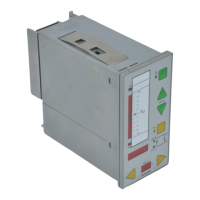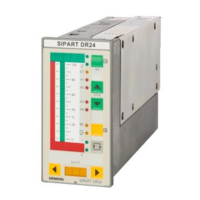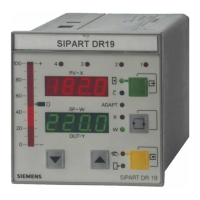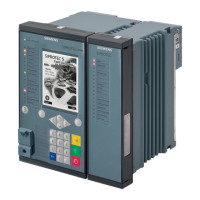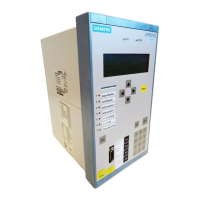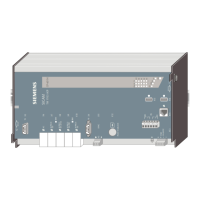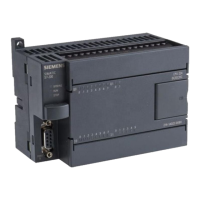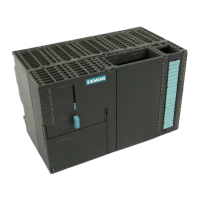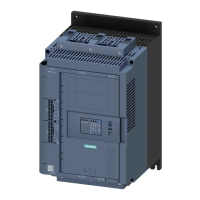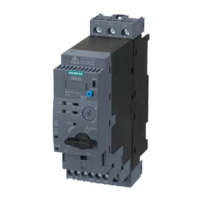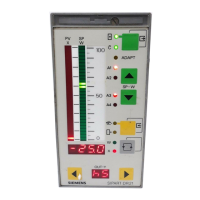
Do you have a question about the Siemens SIPART DR21 and is the answer not in the manual?
| Category | Controller |
|---|---|
| Power Supply | 24 V DC |
| Communication Protocol | HART |
| Protection Class | IP65 |
| Display | LCD |
| Housing | Aluminum |
| Input Signal | 4-20 mA |
| Output Signal | 0/4-20 mA, 0-10 V, relay, solid state relay |
| Operating Temperature | -20 to +70 °C |
Indicates an imminently hazardous situation which, if not avoided, will result in death or serious injury.
Indicates a potentially hazardous situation which, if not avoided, could result in death or serious injury.
Indicates a potentially hazardous situation which, if not avoided, may result in minor or moderate injury.
Covers general safety warnings, delivered items, standard controllers, options, and documentation.
Warning regarding relay switching voltage limits and resonance.
Explains the controller's operation based on a microcontroller.
Describes programming via structure switches and parameter settings.
Covers installation position, climate class, protection type, electrical safety, and conformity.
Details power supply ratings: voltage, frequency, consumption, and voltage breaks.
Provides technical data for current inputs: signal range, resistance, and error specs.
Details digital input specifications: signal status, resistance, and destruction limit.
Provides technical data for analog outputs: signal range, load voltage, and error specs.
Details relay output specifications: contact material and load capacity.
Explains the role of structure switches in adapting the controller to its task.
Describes slave controller without Int/Ext switching (S1 = 6).
Describes the processing of analog input signals via AD-converter and filters.
Details assignment and effect of digital inputs and linking with control signals.
Introduces different controller types like fixed setpoint and slave controllers.
Explains PID, P, PI control algorithms and D-element connection.
Explains setting the controller direction of effect (S46).
Describes the continuous K-controller and actuating time settings.
Describes the two-position controller and its operating options.
Describes the S-controller with internal feedback for motorized drives.
Describes the S-controller with external feedback for motorized drives.
Describes how automatic mode is activated and its behavior.
Explains manual mode activation via key or control signal He.
Describes tracking operation activated by control signal N or CB.
Explains safety operation activated by control signal Si.
Describes assignment of controller variables to the analog output.
Details assignments for message signals to digital outputs.
Explains the meaning of digital output signals like RB, RC, H, Nw, Alarms, MUF.
Describes the system identification process for adaptation.
Describes the assignment and function of limit value alarms A1 to A4.
Explains the linearizer function assignable to analog inputs or controlled variable.
Covers site selection, work prior to installation, and backplane module removal.
Covers general warnings and the arrangement of connecting elements.
Describes connecting the PE conductor to the ground screw.
Explains connecting the power supply via plugs for AC and UC systems.
Describes connecting process signals via plug-in terminal blocks.
Details power supply connection for standard controllers (115/230V AC and 24V UC).
Describes wiring for analog inputs AI1 and AI2.
Describes modules for analog measuring inputs.
Introduces operating modes (process, selection, configuration) and operating locks.
Describes control elements, actual value, setpoint, and manipulated variable displays.
Provides an overview of navigating through selection and configuration modes.
Explains the differences and operation in online and offline configuration modes.
Details offline parameters for basic functions like display ranges and limit values.
Describes setting measuring ranges for UNI-module via CAE3 menu.
Details setting measuring range for mV inputs.
Describes setting measuring range for thermocouples with external reference.
Describes setting measuring range for PT100 sensors (2-wire).
Details setting measuring range for U or I inputs.
Details setting measuring range for PT100 sensors (4-wire and 3-wire).
Details setting measuring range for resistance potentiometers.
Describes setting measuring range for thermocouples with internal reference.
Details the parameters adjustable in the online parameterization mode (onPA).
Covers conditions, pre-adaptation, during adaptation, and aborted adaptation.
Describes the structure switch configuration mode (StrS).
Lists structure switches for controller type, output structure, and input signals.
Describes the APSt function to reset all parameters and structures to factory settings.
Lists error messages detected by the CPU self-monitoring.
Explains how to adapt the control action direction to the system and actuator.
Recommends adaptation for automatic control parameter setting.
Details adaptation procedures for S-controllers with different outputs.
Step-by-step guide for manually setting P-controller parameters.
Step-by-step guide for manually setting PD-controller parameters.
Step-by-step guide for manually setting PI-controller parameters.
Step-by-step guide for manually setting PID-controller parameters.
Provides rules of thumb for setting Kp based on transient function.
Provides rules of thumb for setting Kp and Tn based on transient function.
Provides general information on maintenance and handling precautions.
